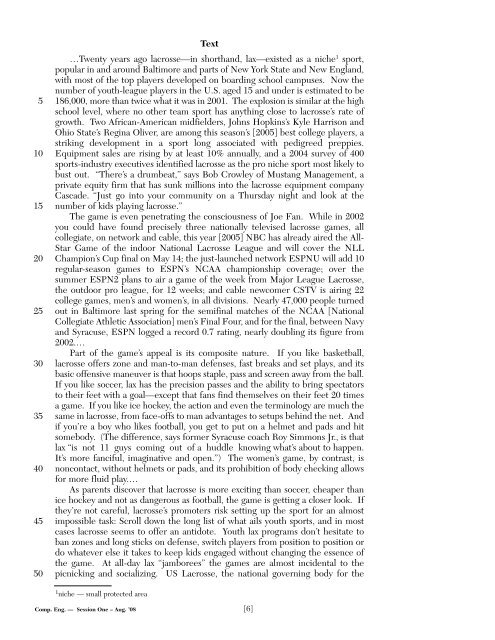SESSION ONE - JMap
SESSION ONE - JMap
SESSION ONE - JMap
Create successful ePaper yourself
Turn your PDF publications into a flip-book with our unique Google optimized e-Paper software.
5<br />
10<br />
15<br />
20<br />
25<br />
30<br />
35<br />
40<br />
45<br />
50<br />
Text<br />
…Twenty years ago lacrosse—in shorthand, lax—existed as a niche 1 sport,<br />
popular in and around Baltimore and parts of New York State and New England,<br />
with most of the top players developed on boarding school campuses. Now the<br />
number of youth-league players in the U.S. aged 15 and under is estimated to be<br />
186,000, more than twice what it was in 2001. The explosion is similar at the high<br />
school level, where no other team sport has anything close to lacrosse’s rate of<br />
growth. Two African-American midfielders, Johns Hopkins’s Kyle Harrison and<br />
Ohio State’s Regina Oliver, are among this season’s [2005] best college players, a<br />
striking development in a sport long associated with pedigreed preppies.<br />
Equipment sales are rising by at least 10% annually, and a 2004 survey of 400<br />
sports-industry executives identified lacrosse as the pro niche sport most likely to<br />
bust out. “There’s a drumbeat,” says Bob Crowley of Mustang Management, a<br />
private equity firm that has sunk millions into the lacrosse equipment company<br />
Cascade. “Just go into your community on a Thursday night and look at the<br />
number of kids playing lacrosse.”<br />
The game is even penetrating the consciousness of Joe Fan. While in 2002<br />
you could have found precisely three nationally televised lacrosse games, all<br />
collegiate, on network and cable, this year [2005] NBC has already aired the All-<br />
Star Game of the indoor National Lacrosse League and will cover the NLL<br />
Champion’s Cup final on May 14; the just-launched network ESPNU will add 10<br />
regular-season games to ESPN’s NCAA championship coverage; over the<br />
summer ESPN2 plans to air a game of the week from Major League Lacrosse,<br />
the outdoor pro league, for 12 weeks; and cable newcomer CSTV is airing 22<br />
college games, men’s and women’s, in all divisions. Nearly 47,000 people turned<br />
out in Baltimore last spring for the semifinal matches of the NCAA [National<br />
Collegiate Athletic Association] men’s Final Four, and for the final, between Navy<br />
and Syracuse, ESPN logged a record 0.7 rating, nearly doubling its figure from<br />
2002.…<br />
Part of the game’s appeal is its composite nature. If you like basketball,<br />
lacrosse offers zone and man-to-man defenses, fast breaks and set plays, and its<br />
basic offensive maneuver is that hoops staple, pass and screen away from the ball.<br />
If you like soccer, lax has the precision passes and the ability to bring spectators<br />
to their feet with a goal—except that fans find themselves on their feet 20 times<br />
a game. If you like ice hockey, the action and even the terminology are much the<br />
same in lacrosse, from face-offs to man advantages to setups behind the net. And<br />
if you’re a boy who likes football, you get to put on a helmet and pads and hit<br />
somebody. (The difference, says former Syracuse coach Roy Simmons Jr., is that<br />
lax “is not 11 guys coming out of a huddle knowing what’s about to happen.<br />
It’s more fanciful, imaginative and open.”) The women’s game, by contrast, is<br />
noncontact, without helmets or pads, and its prohibition of body checking allows<br />
for more fluid play.…<br />
As parents discover that lacrosse is more exciting than soccer, cheaper than<br />
ice hockey and not as dangerous as football, the game is getting a closer look. If<br />
they’re not careful, lacrosse’s promoters risk setting up the sport for an almost<br />
impossible task: Scroll down the long list of what ails youth sports, and in most<br />
cases lacrosse seems to offer an antidote. Youth lax programs don’t hesitate to<br />
ban zones and long sticks on defense, switch players from position to position or<br />
do whatever else it takes to keep kids engaged without changing the essence of<br />
the game. At all-day lax “jamborees” the games are almost incidental to the<br />
picnicking and socializing. US Lacrosse, the national governing body for the<br />
1 niche — small protected area<br />
Comp. Eng. — Session One – Aug. ’08 [6]
















